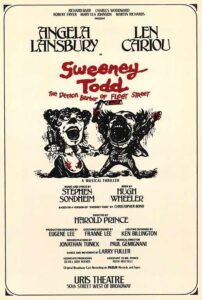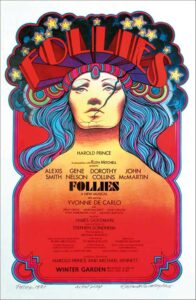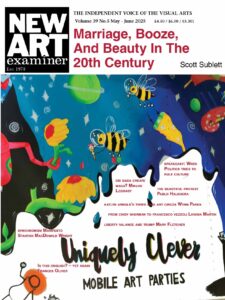
Scott Winfield Sublett
When Stephen Sondheim died last winter at 91, people said, “It was a punch in the gut,” and there followed a burst of eulogism that probably exceeded anything any practitioner of the musical ever received. Considering that almost nobody in the US goes to the theatre anymore, it was pretty remarkable. Further note that Sondheim, after A Funny Thing Happened on the Way to the Forum (which opened 60 years ago and is still his biggest hit), wrote mostly flops, so where were the adoring mourners when the box office was open? Given those ironies, to what degree does his legacy determine the future of the Broadway musical?
Even at the moment of his death, a revival of the triumph that was the fulcrum of his career, Company, graced Broadway. Still running strong as of this writing, it’s the gender-swapped version that originated in London. Criticism that setting the 52-year-old show in the present was a mistake, and that turning Bobby into female ‘Bobbie’ was little more than switching pronouns, were swept away in waves of adulation from audiences that whooped, cheered, and thoroughly ignored the apostical carping of The New York Times. The cult of Sondheim lives, and maybe the whole notion of a ‘canon’ is out of fashion, but Sondheim’s in it. He’ll be revived—but will the Sondheim style live on?
It might help to characterize that style, and how it differs from what came before it. Teen-aged Stephen was famously mentored by family friend Oscar Hammerstein II, who devised the books for Show Boat and Oklahoma, thus transforming forever what was then called (and would be called for a few more years) musical comedy. He achieved a synthesis that married well-made, three-act plot structures to songs that were essential to the narrative—songs not always “forwarding the plot,” but at least taking the story deeper or higher, and always, always, perfectly spotted within the plot, and necessary, never forced or arbitrary. With seeming effortlessness, he, with Rogers wrote long plays that never bored (apart from the very occasional flop). The Hammerstein style was inevitable, timeless, and with him the Broadway musical achieved a kind of classical perfection. The ‘book musical’ a la Hammerstein, if you date it from the opening night of Oklahoma in 1941, has been with us more than 80 years, and if you date it to Show Boat, it’s been about a century.
differs from what came before it. Teen-aged Stephen was famously mentored by family friend Oscar Hammerstein II, who devised the books for Show Boat and Oklahoma, thus transforming forever what was then called (and would be called for a few more years) musical comedy. He achieved a synthesis that married well-made, three-act plot structures to songs that were essential to the narrative—songs not always “forwarding the plot,” but at least taking the story deeper or higher, and always, always, perfectly spotted within the plot, and necessary, never forced or arbitrary. With seeming effortlessness, he, with Rogers wrote long plays that never bored (apart from the very occasional flop). The Hammerstein style was inevitable, timeless, and with him the Broadway musical achieved a kind of classical perfection. The ‘book musical’ a la Hammerstein, if you date it from the opening night of Oklahoma in 1941, has been with us more than 80 years, and if you date it to Show Boat, it’s been about a century.
“I was 11 years old, I met Oscar Hammerstein, and he became a surrogate father, and I just wanted to do what he did,” Sondheim said. “And he was a songwriter for the theater, so I became a songwriter for the theater. If he was a geologist, I would have become a geologist. Which is, I’m sure, an exaggeration, but not tremendously.”
Tutored by a genius, Sondheim pretty much knew everything there was to know about the classical book musical while still in his teens, and worked brilliantly within that tradition in his 20s as the lyricist for Gypsy and West Side Story. He was hardly more than 30 when he did the lyrics, and music, too, for A Funny Thing Happened on the Way to the Forum, the longest running show he would ever write.
So much mastery, so soon, and if the restlessly brilliant son was to move beyond what the father had taught, there was no choice but to venture beyond the pale—a dangerous place for a practitioner of an expensive art form. Sondheim had to do new things (new to the Broadway musical if not to theatre in general) and the Sondheim Style (he’d deny there was such a thing because he consciously tried not to repeat himself, but even rule-breakers make new rules) employed elements that mitigated against popular acceptance. Such as:
1) When it comes to theme and tone, cynicism and darkness are smart, while sentiment, romance and optimism are childish. Never would Sondheim write a lyric like Oscar Hammerstein’s wholesome confession from a character that she’s “stuck like a dope with a thing called hope.” The song was an explicit (and faux apologetic) denunciation of the sophisticated pessimism Sondheim would embrace. He reveled in regret, ambivalence, solitude, and grimness to the point of grand guignol. And, of course, less-than-happy endings: Bobby doesn’t get the girl and Bobbie doesn’t get the boy. In that, Sondheim starts to look prescient. In the newest musicals in the New York pipeline, it seems that, more often than not, the couple doesn’t wind up together. And that’s not presented as a wholly unhappy outcome: rejecting the suitor is a triumph of feminism, or maybe independence of spirit. Even revivals aren’t safe. The 2018 My Fair Lady at Lincoln Center ended with Eliza walking out on Henry Higgins! Sure, she did that in Pygmalion, but in Pygmalion they hadn’t just spent two hours singing I-hate-you-till-I’ll-love-you-at-the-end-of-the-play songs to each other. Romantic failure shows signs of becoming entrenched in the musicals that win awards, for example Hadestown and A Strange Loop.
2) Dialogue is bad; the more sung-through the musical, the better. The “sung through musical,” which is to say no dialogue (or a little bit scattered throughout) used to go by other name – ‘operetta’ and ‘opera.’ It’s certainly not Sondheim’s sole mode, but after Sweeney Todd a lot of people were convinced that the sung-through musical was somehow more pure than a musical festooned with a lot of nasty scenes of spoken drama. This article of faith seems akin to the notion that the more silent a movie is, the more “cinematic” (so much for Casablanca and All About Eve). Evita, Hamilton and Hadestown demonstrate the ascendance of the no-dialogue style. Can musicals achieve complexity of character, real conflict, and thematic depth if no dramatic scenes are served along with the music?
3) Chronological, linear plotting, also called ’three-act structure,’ is corny and limiting. Plot is somehow inimical to honesty and seriousness. A story that moves ahead through conflict, a chain of events connected by cause and effect, is thought to be less serious and honest than non-linear, non-chronological, experimental plotting, organizing the play around a theme rather than a plot. Near the end of his life, Sondheim had been wrestling with for many years with Square One, a musical in which act one would be based on surrealist Luis Buñuel’s Discreet Charm of the Bourgeoisie, and act two based on Buñuel’s Exterminating Angel. If you know those two (great) films, which are about stasis, you know that less likely source material for a Broadway musical could hardly be found – but then again, who would’ve predicted that the dark, rambling documentary Gray Gardens could be made into a ravishing musical?
Critics and artists are always saying people hate things because they’re new, but sometimes, after a while, they’re no longer new and people still hate them. What’s more, sometimes the people don’t hate newness; Oklahoma was new, and nobody was scared and everybody loved it. It’s possible that linear, chronological, cause-and-effect storytelling is something the human brain is wired to prefer (and has preferred in theatre for over two millennia – and it’s still liked on TV, too). Then again, technology is rapidly re-wiring our brains, and little dribs and drabs of tenuously connected information are less disconcerting than they once were, and may indeed come to seem preferable. And that’s certainly an easier way, for the writer, to organize a narrative. Classical plotting is hard. A musical is an incredibly complex mechanism – plot, character, theme, style, music, lyrics, dance, all integrated into a whole that moves ceaselessly through the dimension of time. Does that become easier if we ease out plot? Are meaning and plot really enemies? Is classical plotting really “too easy,” or in fact, too hard?
 It’s worth noting that Sondheim’s favorite musicals – Porgy and Bess, Carousel, She Loves Me, and The Wiz – all have strong, classically constructed plots. That kind of musical isn’t going away, but neither is the Sondheim Style. The continuing popularity of musicals that are (at least partially) thematically and episodically organized, such as Chicago, A Chorus Line, and more recently, A Strange Loop, prove that even Broadway audiences are open to experimentation and anti-narrative. And Sondheim’s most successful experiments – masterworks such as Company, Follies and Sunday in the Park with George – will always be important milestones. Asked, in his last major interview, where he thought the Broadway musical was headed, Sondheim was cagey: “Whither Broadway? I don’t answer the question. Who knows. I don’t really care. That’s the future. Whatever happens will happen.”
It’s worth noting that Sondheim’s favorite musicals – Porgy and Bess, Carousel, She Loves Me, and The Wiz – all have strong, classically constructed plots. That kind of musical isn’t going away, but neither is the Sondheim Style. The continuing popularity of musicals that are (at least partially) thematically and episodically organized, such as Chicago, A Chorus Line, and more recently, A Strange Loop, prove that even Broadway audiences are open to experimentation and anti-narrative. And Sondheim’s most successful experiments – masterworks such as Company, Follies and Sunday in the Park with George – will always be important milestones. Asked, in his last major interview, where he thought the Broadway musical was headed, Sondheim was cagey: “Whither Broadway? I don’t answer the question. Who knows. I don’t really care. That’s the future. Whatever happens will happen.”
For over 60 years, what happened … was Sondheim.

